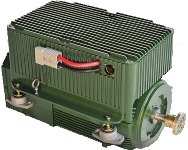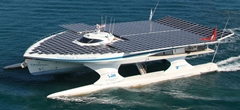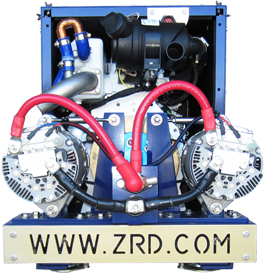 |

Pictures say everything here |
Due to the increasing popularity with the concept of all-electric or hybrid propulsion, ZRD has added this FAQ. We have been answering a lot of inquiries regarding ZRD DC Generators as the ultimate charging source and/or the source of DC output to power their electric propulsion conversions. It is with regret that we must pass on the following information regarding those endeavors. Below follows some conversations with current electric boat owners, prospective diesel propulsion conversions, boat builders, and ZRD with an insight into their thoughts, concepts, observations, and ZRD's feedback with lessons learned over the years. For those that are considering such a conversion, the ultimate decision is yours to make after reading the following conversations and doing your homework.
To start, the following is typical beginning of a conversation between ZRD and the person looking for answers.
• The first thing that needs to be communicated clearly is "What are your specific needs/requirements?"
• Specifically, Is your goal to be able to supply XX kw yy volt on the vessel?
• If yes, for what length of time?
• Do you want a battery bank to do this?
• Run a generator?
• All of the above determines Battery Bank sizing and then the correct alternator sizing to recharge it in the required time frame?
• From there, a solution can be developed to meet your needs.
Conversation #1 - Desires 100% Electric Solution
|
I am planning to build a 45 foot catamaran with 2 x 10 kw 48 v electric motors. We are planning to use 48vdc/400ah battery bank. The vessel will also have much electrical
equipment. This boat will be an ocean going trawler. Please send me information and pricing for a suitable DC Generator.
Combined Partial Summary of ZRD responses ZRD manufactures a 12KW DC Generator. ZRD does not desire to discourage you, but we know first-hand and from former prospects (not customers) that electric propulsion is NOT the way to do it. Unfortunately, the best way is still a diesel engine connected directly to a propeller. DC should run everything on a vessel (including 120vac equipment via inverter) except for propulsion. Technology has not been developed yet to drive a boat efficiently by all electrical means. Depending on how you word it or what ratios you like to use, running from a diesel engine directly (skipping Tx for discussion) to a prop is 5-10 times (500-1,000%) more efficient than an Electric motor driving a prop when you include the energy required to recharge the battery bank. Also the time before a battery bank is 100% exhausted is from 1 hour to a few minutes depending on the speed used. This speed is almost certainly considerably less than Direct Diesel Engine propulsion. Hybrid may be an option, but it has its own problems. The HP output of 1 gallon of diesel far exceeds the AH (amp-hour) output of 600+pounds of battery (1,000ah @ 12volts). I can move 28,000lbs of boat for 5 miles @ 10mph on a gallon of diesel. A 600+ pound battery bank would be 100% gone before that point were ever reached. When 1,000ah of battery is the size & weight of a flashlight D cell, then we will be there, but certainly not now. The "luxury" land based automobiles have vs. marine based transportation is not a parallel to be considered. In addition, the 100% electric cars coming on the market now have 1/16 to 1/8 of the distance capabilities of gasoline vehicles. Even then they do not have a 10 minute stop for refuelling - requires overnight. For going to work (if not far) or the grocery they are usually OK, but try and take a trip over 100 miles - and most vehicles now can go 450-800 miles on a tankful of gas. That same scenario in a boat is typically less than an hour of operation or 5 miles - whichever comes first. And that is at idle power. Put the engine up to high speed and the batteries are usually dead in 20 minutes. ZRD's first interaction with all-electric was a number of years ago with a customer purchasing 18 batteries for his all electric 18' Duffy "motor" boat - basically an oversized dingy. The 18 batteries had combined total of 1,980 AH at 12vdc of power - Duffies are currently set up at 48 Vdc, but using 12vdc for ease of explanation. He showed me how far he could go at idle (2-3mph) on the water when he pointed to a bridge approximately 2-3 miles away. He was never sure he would make it back before the batteries were exhausted and dead. He never used full throttle (6 mph) or he would not even make the bridge. This glaring reality of what it takes to move a boat electrically was an eye opener. |
Conversation #2 - Actually Did 100% Electric Conversion
| ZRD recently had a lengthy phone and email conversation with a gentleman looking for a custom DC Generator to power his 33foot all electric sailboat - He removed his diesel propulsion engine and went all electric 5 years ago. He said he is one of the few sailors that actually sails his boat vs. motoring - He stated it was because he had to regardless of weather conditions because he could only motor for 20 minutes before he needed to "plug-in". He is resigned to using his electric power only for in and out of marinas as he docks - Never underway. Some days he only gets a few miles when travelling - depending on wind speed and direction. He left Canada on the Great Lakes, travelled NE on the St Lawrence River, entered the Atlantic and came down the east coast of the US. He contacted ZRD as he passed FL. He is now evaluating going back to diesel propulsion at considerable expense. |
Conversation #3 - Desires Very Large Independent Hybrid Solution
|
• We would like to have a design for 20kW, if possible, more.
• The start of our design is an alternator. • We would like to see which voltages and amps are available. We will use 24 volt batteries (cable diemsions will be high). • We would like to supply a 24kw load by using batteries for 1 hour. • Only batteries and charge alternators on during this time period. • During propulsion, two alternators are always on so we should get the biggest alternators you have. • According to total battery capacity, we will change in a time frame of one hour or less. • When the battery voltage decreases, we will run the generator. • We are going to organize a good power management system to change from battery-charge alternator-inveter power to generator power. |
Combined Partial Summary of ZRD responses
|
The Total number of batteries (12vdc 255AH each) required to supply 24KW is greater than 12 (@ 100% eff) with a 50% Discharge for 30 minutes. If kept going for an Hour (not
recommended on a regular basis) they will be 100% discharged and risk permanent failure. The Total number of batteries (12vdc 255AH each) required to supply 24KW is greater
than 24 (@ 100% eff) with a 50% Discharge after 1 hour. Based on the above, it will require two alternators running @ full output in excess of 13 hours each to recharge.
This situation is conducive to premature alternator failure. Massive cooling would be required to assist in their longevity. A ZRD dedicated 24v DC Generator capable of 500
amps is the only possible solution - even then there may be problems. The alternator used on this DC Generator is not available to be used as a second (dual) alternator on your
propulsion engine. The propulsion engine was not designed for the side loading and will cause engine failure.
Hybrids work, but why do it at all? Hybrids when necessary or required are justified, but not just to do it - especially on a pleasure craft. When you consider it only adds $$$$+ to the price. At the current stage of technology, it is just Hype. Do not confuse please vessel Hybrid with DC electric propulsion of the type used in Trains or on the pods of large vessels like the Queen Mary 2. These are a form to themselves not available or applicable to the average boater. Prospect(s) Reply First I will explain why we do not want to use a generator. As you know, all over the world the new trend is green vessels. Our boat operates with both engines running most of the time with the transmission in neutral. During this time we would like to use this power which is wasted by the engines. This would continue for weeks until reality was finally clear enough to be understood. |
Actual (Vendor Provided) Electric Propulsion Specifications:
(Items that ZRD considers Suspect are shown in Red; Those that are Functionally Significant and Defect in Results are shown in Blue)
|
Boat size ranges: 38' - 56'
Horsepower diesel equivalent: 70 h.p. Miles Per Gallon Equivalent: 33 mpg Cruising speed 60% - 80% of hull speed: 7-8.5 knots Cruising time 60% - 80% of hull speed: 6-2 hours Cruising range 60% - 80% of hull speed: 35-17 nm Recharging time standard charger (shore power-50% depth of discharge): 4-5 hours Recharging time quick charger (shore power-50% depth of discharge): 3-4 hours Number of 12 volt 8-D batteries (255 Ah each): 18 batteries Battery bank voltage in total: 108 Vdc Amps (maximum): 262 amps Kilowatts (maximum full power from batteries): 28.2 kW Number of chargers required: 2 chargers |
As you read the ZRD website, it should be very obvious ZRD is a big fan of DC. In fact, ZRD is doing its best to prove Edison correct and Westinghouse and Tesla wrong. Our overall view for cruisers that are looking toward electric propulsion as a possible solution to solve the rising fuel costs and helping the environment - If you are being told DC propulsion is a viable answer today, we feel you are being misinformed if relying on diesel for electric propulsion power generation due to its inefficient (compared to diesel direct) design (physics) and upside down costs. Hopefully, someday. If 100% solar (look at top image to see how much is required), it is possible, but consider the cost, ...
Special Dedicated Design Specifications and Installation:
Some sailing vessel (most are catamarans) builders are designing into the foundation of their designs to not have or use direct diesel propulsion. They desire to only use electric propulsion and in limited operations. With this design specification, sailing is the desired source of vessel propulsion in all situations. The Electric propulsion back-up option is reserved strictly for harbor and required limited no-wind operations only. The vessel operator has knowingly accepted this limited/restricted operational scenario. In this scenario, electric propulsion is the chosen option and ZRD's 12Kw DC Generator is the sensible viable solution.
 |
 |
Note:
Do not miss our FAQ on Lithium Battery Systems